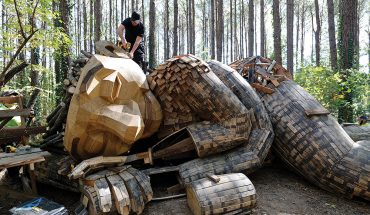BUILT TO LAST
Raleigh’s new Holy Name of Jesus Cathedral
by Mimi Montgomery
all renderings by O’Brien & Keane Architecture
If you’ve driven on Western Boulevard toward downtown recently, you’ve likely noticed a colossal new copper dome emerging through the trees, its façade already adopting the patina of verdigris.
That dome is the calling card of Holy Name of Jesus Cathedral, a $41 million project funded by 28,000 donors that has been under construction for two years and will officially open this month as the seat of the Catholic Diocese of Raleigh, which oversees the eastern part of the state.
It is massive, ranking as the largest cathedral in North Carolina, and the fifth-largest in the United States. With 80-foot ceilings and room for 2,000 worshippers, the space, the Catholic church says, is much needed.
When the Diocese of Raleigh was founded in 1924, it represented all North Carolina Catholics, which then numbered about 6,200. Today, the Diocese only represents the eastern part of the State (the Diocese of Charlotte represents the west), and the number of worshippers it represents is about 225,000. That number is anticipated to keep growing. As many as 25 percent of the folks moving to the booming Triangle are Catholic, says the Rev. Monsignor David Brockman, pastor of Wake Forest’s St. Catherine of Siena Catholic Church and a cathedral committee head. This expanding group will need a spiritual home, a place to worship, gather, and contribute to their rapidly growing community.
The best way to do that? Build something with room to grow, the church says; something meant to last several centuries.
Building on a legacy
Taken from the Latin cathedra, which means “chair,” a cathedral is any church that serves as the seat of a diocese’s bishop. Of course, these are not structures built every day – they’re significant architectural undertakings.
So it’s appropriate that the cathedral sits on a prominent rise of historic church land situated between Centennial Parkway and Western Boulevard, on the edge of N.C. State’s campus. The land was originally purchased in 1899 by Father Thomas Frederick Price, the first native North Carolinian to be ordained a Catholic priest, and currently being considered for canonization as a saint. He established Nazareth Orphanage on the site, and it eventually became the location of Cardinal Gibbons High School.
Now it’s a magnificent new home for Holy Name. The cathedral replaces downtown’s Sacred Heart Cathedral as the diocesan seat. Built in 1924, Sacred Heart’s 300-person capacity has long been far too small for the Diocese, or even for its 7,273 regular parishioners. It’s listed as the smallest cathedral in the continental United States, and currently scrambles to host up to 11 masses every weekend to accommodate its worshippers.
A gathering place that would house the region’s growing Catholic faith and remain usable for generations to come has long been considered a necessity. Given the rarity of cathedral construction, it can be difficult to find the right architect for such a project. But Jim O’Brien of O’Brien & Keane Architecture in Arlington, Virginia, who has worked on several churches, fit the bill. Holy Name is by far his biggest undertaking to date. “It’s a project of a lifetime, really,” says O’Brien, a practicing Catholic who looked to the religion’s traditions as inspiration. “We have a tremendous advantage of having quite a legacy of 2,000 years of building churches and cathedrals … so it’s easy to find precedence and it’s easy to build on that.”
As O’Brien knows, when creating a building meant to embody a legacy, every aesthetic choice is imbued with significance. Thoughtfulness is paramount throughout Holy Name.
The sanctuary is made with creamy white Carrera marble, sourced from the same quarry Michelangelo used for his sculptures. Off-white and grey marble cover the floors, with a flowing pattern that Monsignor Brockman likens to the flow of wine served during the Eucharist. Pews are carved from North Carolina red oak. Statues of saints carved from linden wood found in northern Italy keep guard over the interior (with a space left open for a saint not yet canonized). The cathedral is not situated adjacent to bordering streets, instead it sits at an angle, allowing its front doors to face west and its altar to face east, catching the sun as it rises and sets.
They’re all details meant to stand the test of time. “What we were looking for would be a style of architecture that would never look old; that it would be timeless,” says Monsignor Brockman. “In other words, it would speak to the ages and engage people throughout time.”
Sacred space
If a building is to last centuries, the materials have to be just right. Another step in Holy Name’s long journey was finding the skilled artisans capable of honoring the sacred nature of the space.
Ninety stained glass windows adorn the cathedral’s walls, the largest of which stands at 18 feet tall. Joseph Beyer and his team at Beyer Studio in Philadelphia oversaw the hefty challenge of creating, refurbishing, and installing each window (a process he likens to a root canal in its excruciating difficulty).
Forty of these windows are 1920s antiques taken from Ascension Catholic Church in Philadelphia. Each almost-100-year-old window was taken apart so every facet of glass could be cleaned and reassembled with new lead linings. Beyer estimates his team cleaned over a half-million pieces of glass by hand.
Each of the new windows was also made by hand, honoring the same techniques found in the antique ones. “We have a medium that has not changed essentially since the Middle Ages,” says Beyer. “The beauty of it is that a century from now, when I’m long gone, someone can come to my windows and do to them what I’m doing” to the antiques. He hopes that means his windows will allow “a whole other generation of life here in Raleigh.”
This passion for legacy is evidenced in the cathedral’s commitment to music, as well. C.B. Fisk Inc. of Gloucester, Massachusetts, built the cathedral’s handmade organ. Such a large space requires an instrument of significant power: The organ has a 50-foot-tall case and 3,396 hand-rolled lead and tin pipes ranging from 32 feet to ¾ of an inch. It took an estimated 37,000 hours to complete, and is one of the largest organs the firm has ever constructed.
The home for the organ’s music will also do it justice. Stewart Acoustical Consultants of Cary helped to fashion the cathedral’s acoustics, putting together a computer program that modeled the auditory environment of the structure based on its shape, materials, and length. This allowed the air and heating systems to be modified for the uninterrupted flow of music. The long procedure of the organ’s installation will begin in September, after all post-construction dust has settled. Absolute quiet is required to make sure each note is perfect; it will take 6 to 9 months to “voice” the instrument.
The cathedral will also make music outside its walls. The bell tower’s carillon houses 50 bronze bells constructed by the Verdin Company of Cincinnati, Ohio. Installing each bell was a massive undertaking – the smallest is 18 pounds, but the largest clocks in at 1,980 pounds and 46 inches in diameter. Together, all the bells weigh 13,000 pounds, and can be played manually or via a custom computer. Included is a bell that sat in the Holy Name of Jesus Chapel, which was part of the orphanage Father Price ran on the same plot of land. “It tolled its great tone over that land before, and it’ll be back,” says Monsignor Brockman. “So it’s pretty cool.”
And, of course, there’s the dome. Made of copper and steel, the 65-foot-tall, 160-ton cap was assembled on the ground then lifted, whole, onto the cathedral’s roof via crane. It’s visible from multiple reaches of the city, which is exactly its intended purpose.
“The root of (the word dome) is domus, which means home,” says O’Brien. “It signifies that this is the home of the church in Raleigh, and it’s meant to stand for the entire diocese of eastern North Carolina. It really stands as a witness to the community.”
On July 26, it will officially be deemed the crown of the new cathedral when Holy Name hosts its dedication mass. It’s an event a long time in the making, and one that signifies more than just the opening of a new worship space.
“It draws the eye upwards,” says O’Brien of the dome, and of the cathedral itself. “These days, we’re all looking down so often at our phones or distracted about all the things of this world; to draw the eye upward is very important. It’s been a real blessing.”






